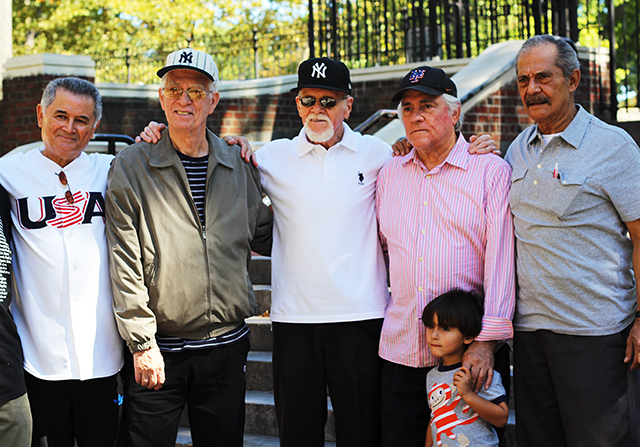The 3rd Avenue Boys
 The Bronx of the 1950s looked much different than it does today. Hector “Tito” Vazquez, 75, moved from Puerto Rico to 3rd Avenue in the Bronx as a child and became fast friends with many of the neighborhood boys. For them, the Bronx and childhood were all about sports: bottle cap, baseball, softball, basketball, stickball and punch ball.
The Bronx of the 1950s looked much different than it does today. Hector “Tito” Vazquez, 75, moved from Puerto Rico to 3rd Avenue in the Bronx as a child and became fast friends with many of the neighborhood boys. For them, the Bronx and childhood were all about sports: bottle cap, baseball, softball, basketball, stickball and punch ball.
No one loved sports the way Vazquez and his friends did. Now many of the gang has moved away, but Vazquez organizes reunions of the 3rd Avenue Boys, where they gather to reminisce about the good old days. One Saturday in September, Wilfred Luquis, Joel “Peanut” Herzberg, Virgilio Caraballo, Hector Vazquez, Willie Luquis, and Leo Ramirez all gathered in front of their old school, P.S. 4 Middle School.
“Friends are very important in life, in fact some friends are better than family members,” Vasquez said.
Vazquez brought a scrapbook he calls “Broken Down Memories,” which included pictures of his youth baseball team and sports clips from back in the day. He brought films from the day, like “The Godfather” and “Westside Story,” baseball bats, a basketball, and the handle of a broom used to play bottle cap. The last is a game similar to stickball and baseball, but instead of a bat and ball, they hit pop-bottle caps with broom handles.
The faces of the Bronx have changed, said Vazquez. When he was growing up, there were mostly Puerto Ricans, Italians and Jews around 3rd Avenue, Washington Avenue and in the West Bronx, said Vasquez. Now, he said, there are more Dominicans than Puerto Ricans in the neighborhood. However, Vazquez still has a little bit of an Italian accent, picked up from his neighbors.
Joel “Peanut” Herzberg hadn’t seen Hector in 57 years. “It’s a really nice day to spend with friends, these are your friends from the Bronx, you don’t have friends like that anymore,” Herzberg said. Herzberg, who lived in Brooklyn, said he would sleep in the Bronx Zoo just to wake up early the next morning to play stickball with his Bronx pals.
He recalled playing ping pong every morning with Vazquez. Today, Now, Herzberg is a professional bowler, traveling the U.S. He shared the general sentiment among the men that kids in the Bronx today are not active like they were. Usually on Saturdays, no one could get in Crotona Park because it used to be extremely crowded, saidVazquez. But now, there is barely anyone there. “They [kids] play on computers, and it’s actually killing the generation,” said Herzberg.
Virgilio Caraballo was another 3rd Avenue boy. Although he lived in Brooklyn, Caraballo would hang out to play stickball and softball with his crew. However, he said he stayed away from baseball, “I didn’t have the height, the ability that Tito [Hector] had,” he said. Many baseball scouts were after Hector, he added, but then he turned 22 and they wanted younger players instead.
Wilfred Luquis described the 1950s as a naïve time. “We were good kids,” he said. It was all about “games, fun, and girls.” Baseball today is disappointing he said. Back then, it cost 35 cents to go to a game, he added. “Drugs didn’t exist then in sports. Occasionally someone would get drunk, but nothing too major compared to now.”
Leo Ramirez recalled winning the PSAL City championship in 1959. “That was my greatest moment of my life in baseball,” Ramirez said. “But the greatest moment in 1950 was meeting my friends.”
Luquis agreed. “The main thing is we kept together up till now,” he said. “We’re talking about 60 years of friendship.”

From the Bronx I remember 15cents to ride the 3rd Avenue El, 25cents for a Spalding. Lee Harvey Oswald attended Junior High School 44 on Crotona Avenue, Crotona pool was 10 cents. The 1965 blackout. Neighborhood changed completely in 1968.